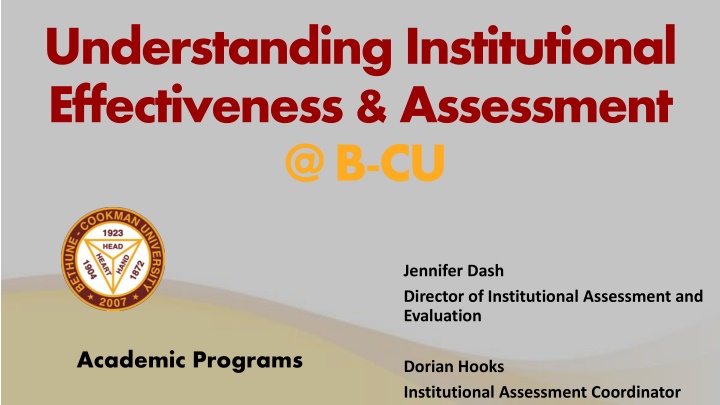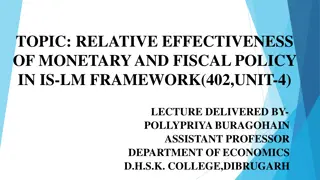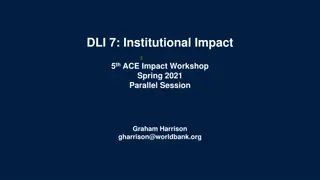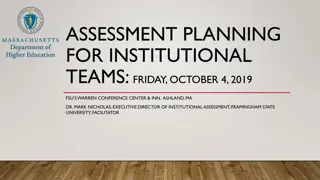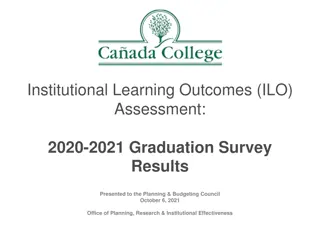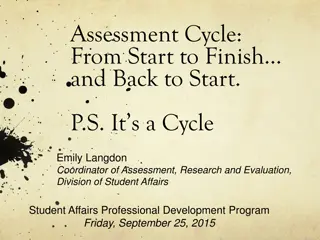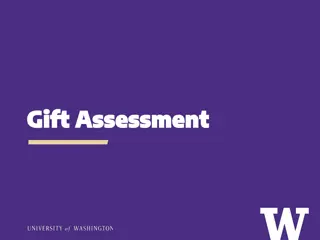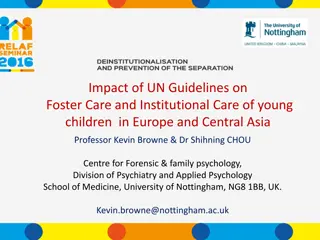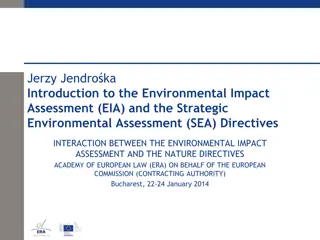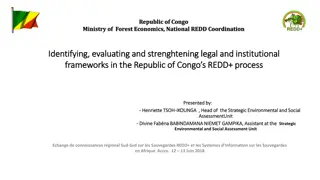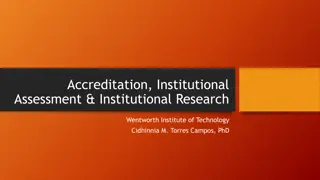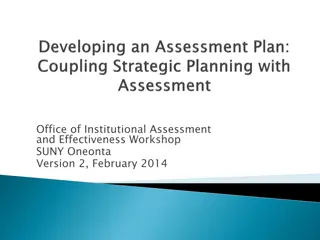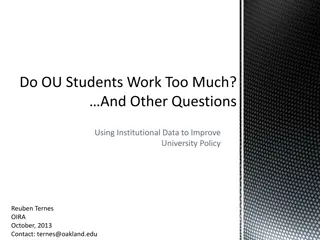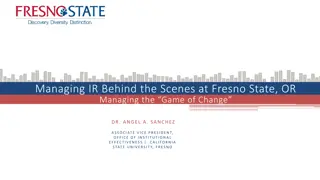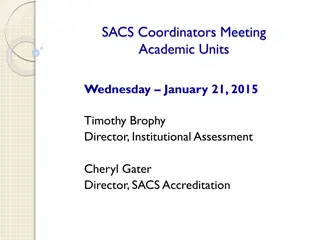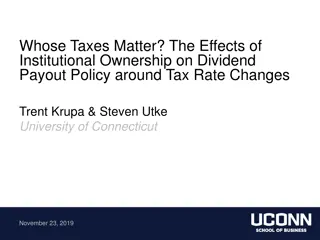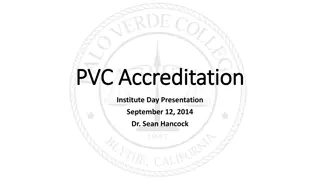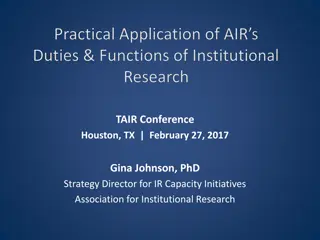Institutional Effectiveness and Assessment at B-CU
Jennifer Dash, Director of Institutional Assessment, and Dorian Hooks, Institutional Assessment Coordinator at B-CU, lead the efforts in understanding institutional effectiveness and assessment. Capacity building, creating a common vision, and a framework for institutional effectiveness are highlighted. The purpose, goals, and components of institutional effectiveness, along with accountability measures, are detailed to engage in a systematic process that monitors the institution's progress towards its mission.
Download Presentation

Please find below an Image/Link to download the presentation.
The content on the website is provided AS IS for your information and personal use only. It may not be sold, licensed, or shared on other websites without obtaining consent from the author.If you encounter any issues during the download, it is possible that the publisher has removed the file from their server.
You are allowed to download the files provided on this website for personal or commercial use, subject to the condition that they are used lawfully. All files are the property of their respective owners.
The content on the website is provided AS IS for your information and personal use only. It may not be sold, licensed, or shared on other websites without obtaining consent from the author.
E N D
Presentation Transcript
Understanding Institutional Effectiveness & Assessment @ B-CU Jennifer Dash Director of Institutional Assessment and Evaluation Academic Programs Dorian Hooks Institutional Assessment Coordinator
Building Capacity Capacity: Our ability to seek solutions to our challenges so that we can achieve our goals and objectives. Capacity building: Should provide faculty and staff the skills and tools needed (state proper outcomes, identify assessments direct and indirect, collection of data, analysis of data, use of data to drive improvement) and strengthen our ability to work together.. Creating the common vision through multiple perspectives that matches Dr. Jackson s vision
Framework for Institutional Effectiveness Purpose Goals Components of IE Accountability
Institutional Effectiveness Purpose: To systematically engage in a process designed to monitor and document the degree to which the institution is progressing together towards accomplishing its Mission. Annual IE Report Accreditation Reports Annual Assessment Report
IE Goals 1. Inform the strategic planning process 2. Promote effective allocation of resources (human & fiscal) 3. Engage faculty and staff in the continuous improvement of the institution s programs and services 4. Provide accountability to stakeholders
Components of IE Planning (Mission-driven plan and review mission simultaneously, integrated into the annual planning and budgeting cycle) Assessment Academic Program Assessment Administrative & Educational Support Services Assessment General Education Assessment University Assessment Feedback Mechanism / Accountability Annual Reports (University, Division, Unit) 1. Annual IE report 2. Annual assessment report 3. Accreditation reports Budgeting(driven by Mission and Division plans) How is the IE process Organized and Coordinated? (Institutional Research, Fiscal, Assessment, IE) How is the IE process supported? (leadership support, IT, faculty and staff development, policies and procedures manual, reporting templates)
Accountability 1. Who is the audience? (Who is responsible?) 2. What are the products? (IE report, Assessment report, Accreditation reports) 3. How do we most effectively communicate (convey information) to stakeholders? 4. What is the process for getting a good product? .
The Art of Explanation The single biggest problem in communication is the illusion that it s taken place. G. Bernard Shaw Source: Keynote Speech AIR Forum Orlando, May 2014, Lee LeFever, Common Craft
A Culture of Evidence Accrediting agencies both at the institutional level and the programmatic level are now operating in a culture of evidence that requires institutions to qualitatively and quantitatively demonstrate that they are meeting student learning goals and effectively marshalling human and fiscal resources toward that end. Michael Middaugh Author of Planning and Assessment in Higher Education
Assessment Plans Descriptive Defines Measures Easy to download Student Learning Outcome Statements Transparency Specific Assessment Use of Student Learning Evidence Targeted to audience Provides examples Describes improvement Defines next steps COMMON TO ALL Clearly worded Prominently posted Updated regularly Receptive to feedback Assessment Resources Easy to download Evidence of Student Learning Interpreted results Contextualized to B-CU Presented graphically Disseminated Current Assessment Activities Defines activities Source: National Institute for Learning Outcomes Assessment (NILOA)
Faculty Mindset No program is so unique that its students are not going to compete with others locally, nationally, and around the globe. Students must learn what is necessary to compete, and it s our job to assess that they are learning and contending with all graduates. Our assessment data tells the story that our students are competitive and ready to move to the next level!
Assessment @ B-CU Assessment is an integral part of the annual planning activities at B-CU, as it determines whether or not the objectives of education are being met. The main goals in the assessment of student learning are: 1. Document what learning is taking place and 2. Utilize the results of assessment activities to improve student learning
Annual Planning & Assessment Report Guide Template
Annual Planning and Budgeting Cycle May - Aug Aug-Oct B-CU collects assessment data to enhance student learning outcomes in an ongoing, faculty-drivencontinuous improvement cycle by adhering to an assessment plan. Analyze data and recommend improvements Collect, aggregate, disaggregate, and share data Review / revise Annual Plans VP, Deans, Department Chairs and Directors submit Annual Report for the upcoming academic year. October The deadline for the Annual Planning and Assessment Report for the 2024-25 academic year is June 2025.
Elements of the Report 1. 2. 3. 4. 5. 6. 7. 8. 9. Description of the Program Mission Statement of the Program Program Student Learning Outcomes Curriculum Map (IRMA) Assessment Map Annual Planning and Assessment Grid Assessment Plan Methods and Procedures Rubric for Assessing the Annual Assessment Report Program Data Collection
Description of the Program In this section, provide a brief overview of your program. Oftentimes, this description can be taken from the program s description in the Academic catalog for the current year.
Mission Remember that the mission of the program must be aligned with the Mission of the University and demonstrate that it supports the Mission of the University. The mission of Bethune-Cookman University is to educate a diverse community of learners to become responsible, productive citizens and solution seekers through the promotion of faith, scholarship, creative endeavors, leadership and service. (Revised and approved by the Bethune-Cookman University Board of Trustees, January 17, 2020)
Program Student Learning Outcomes While some refinement of PSLOs is warranted from year to year, the purpose is to clearly identify your current program PSLOs rather than to develop a revised set of PSLOs. Programs will also complete a periodic Program and Curriculum Review to ensure relevance, timeliness, and program rigor where the need for new PSLOs will arise.
Curriculum Map Map where each PSLO will be assessed in the curriculum. Key: It is typical to use multiple courses (two to three) to assess a PSLO.
Curriculum Map Program Curriculum Map Program Name_______________________________________________________________________ Course 1 Course 2 Course 3 Course 4 Course 5 Course 6 Course 7 PSLO 1 PSLO 2 PSLO 3 PSLO 4
Curriculum Map Your program has a complete IRMA chart that aligns ISLOs, School Learning Outcomes (where applicable), PSLOs, and CSLOs. The curriculum map for the Annual Planning and Assessment Report is different from your complete IRMA chart. On the chart for this report, list the two or three primary courses where programmatic assessment of the student learning outcomes takes place in the curriculum.
Curriculum Map Designations I = Introduced. An I indicates that the students are being introduced to the outcome and the course covers material related to the PSLO. Best practice = Students introduced to all PSLOs early in the program and then be given sufficient opportunities to practice and be reinforced through a formative process before an assessment of their final level of mastery occurs. R = Reinforced.An R indicates that the outcome will be reinforced in the course, and the students are given ample opportunities to learn and practices.
Curriculum Map Designations M = Mastered. An M indicates that in the course students will be expected demonstrate mastery of the outcome. A = Assessed. An A indicates where evidence and data will be collected for assessment purposes.
Curriculum Map Example MAT 334 - Differential Equations MAT 437 - Complex Variables I MAT 332 - Advanced Calculus MAT 095 - Beginning Algebra MAT 499 - Senior Seminar II MAT 498 - Senior Seminar I MAT 131-Mathematics for Liberal Arts IA PSLO 1 I RA MA PSLO 2 IA RA MA MA PSLO 3 PSLO 4 I RA MA MA MA IA RA
Assessment Map Complete the Program Assessment Map using the grid provided by entering at least two assessments for each PSLO (the same assessment can be used for more than one PLSO). Explicitly state the following: 1. Whether the assessment you are using is a direct measure or an indirect measure 2. Course in which the assessment will be completed (e.g. BI 131). If post-graduation, simply state it.
Direct vs. Indirect Measures Method Direct Indirect Method Direct Indirect Locally Developed Written Exams (and Exam Questions) Exit and Other Interviews Simulations External Examiner Behavioral Observations Written Surveys Questionnaires Archival Data Portfolios Capstone Projects, Senior Theses Oral Exams Artifact/Reflection Focus Groups Written Work, Presentations, Performances, Scored on a Rubric Course Grades and Grade Distributions Pass Rates or Scores on Licensure Tests Job / Grad School Placement Performance Appraisal Standardized Exams
Assessment Map Program Assessment Map Program Name_________________________________________________________________________ Assessment 1 Assessment 2 Assessment 3 Assessment 4 Assessment 5 Assessment 6 Assessment 7 PSLO 1 PSLO 2 PSLO 3 PSLO 4
Annual Planning & Assessment Grid Purposes: Show the summation and results of data analysis Tie the assessment plan to any identified, targeted strategic goals Reveal the program s expected levels of achievement Report if the targeted level of achievement was met Explainhow your program plans on using the results in terms of actions
Annual Planning & Assessment Grid Annual Planning and Assessment (Previous Academic Year) Mission Statement: Targeted Strategic Goal(s): Institutional Student Learning Outcome(s) addressed: Student Learning Outcomes (PSLOs) Expected Level of Achievement Measure/Tool Results Use of Results (to include analysis and Action Plan) Met Not Met Other Programmatic Outcomes Expected Level of Achievement Measure/Tool Results Use of Results Met Not Met
Annual Planning & Assessment Grid Annual Planning and Assessment (Current Academic Year) Mission Statement: Targeted Strategic Goal(s): Institutional Student Learning Outcome(s) addressed: Student Learning Outcomes (PSLOs) Expected Level of Achievement Measure/Tool Other Programmatic Outcomes Expected Level of Achievement Measure/Tool
Assessment Plan Methods & Procedures Describe the methods and procedures used to assess the program. Be sure to use the questions below to thoroughly cover methods and procedures involved in your assessment plan. 1. 2. Who was/will be involved in the process of reviewing and revising the assessments? What is the difference between the previous program assessments and the revised assessments? How will the assessments be collected? Who will collect the assessments? When will the assessments be collected? Who will aggregate and disaggregate the data? Who will analyze the data? How are / will data (be) used to drive improvement? How do you want to share the information with stakeholders? 3. 4. 5. 6. 7. 8. 9.
Program Data Collection Data Requested Results Comments 1 2 3 4 5 Name of 5 peer institutions used for program comparison Percentage of courses taught by full-time faculty Percentage of courses taught by part-time faculty
THANK YOU! For additional information and resources fee free to reach out to the Office of Institutional Effectiveness Directly.
